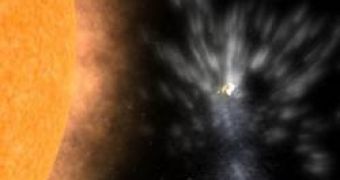There are numerous comets orbiting through the inner solar system, but where this huge amount of objects comes from is largely unknown. Now astronomers have suggested that many short orbit comets could in fact be fragments of much larger objects that break up into multiple pieces as they enter the inner solar system and interact gravitationally with the planets.
Short-period comets originate in the Kuiper belt of objects located beyond the orbit of Neptune, most of which have orbital periods less than 200 years. Some of these objects will eventually interact gravitationally with one of the outer planets and will be pushed towards the central region of the solar system. But observations reveal that there are a few objects in the Kuiper belt that actually have vulnerable orbits which will eventually send them towards the Sun, and even the population of comets that we've mentioned above is very likely to be routinely cut down by the heat of the Sun and eventually ejected out of the solar system.
Simply put, there are not enough objects coming from the Kuiper belt to account for more than 10,000 short period comets. Estimations indicate that the rate at which Kuiper belt objects are attracted into the inner regions of the solar system is about 1/500th of that necessary to match the number of short period comets.
However, if large objects emerging from the Kuiper belt broke into 100 to 1,000 pieces as they fall towards the Sun, it would be just enough to explain the presence of the large population of comets we see today. The theory is supported by previous observations that suggested that comets could split when encountering the strong gravitational pull of a planet.
"Comets are thought generally to be pretty fragile," said Renu Malhotra of the University of Arizona, co-author of the study.
"I know of no evidence that comets can break into 100 or 1000 pieces," said Luke Dones of the Southwest Research Institute in Boulder, suggesting that smaller objects in stable orbits inside the Kuiper belt could account for the large number of short period comets, although only a few are actually sent into the inner solar system.

 14 DAY TRIAL //
14 DAY TRIAL //